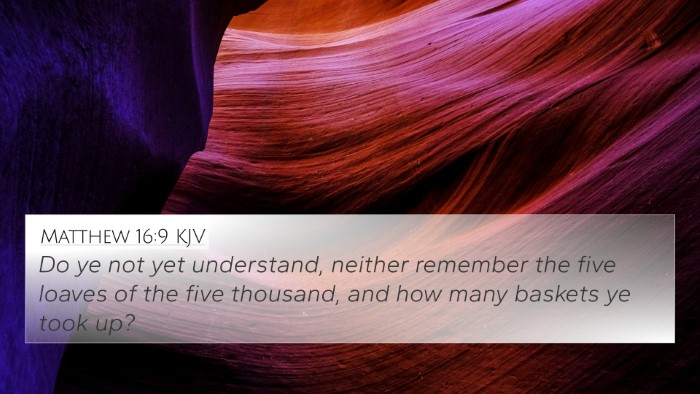Understanding John 16:18: A Comprehensive Analysis
John 16:18 states: “They said therefore, What is this that he saith, A little while? We cannot tell what he saith.” This passage captures a moment of confusion among Jesus’ disciples as they grapple with His cryptic language regarding His impending departure. To understand this verse deeply, we can draw insights from various public domain commentaries that explore its meaning and implications. Below, we summarize these insights along with relevant cross-references and connections between scripture.
Interpretation of John 16:18
This verse occurs during the discourse of Jesus to His disciples before His crucifixion. They are concerned about the implications of His words as He discusses leaving them, which leads to a series of questions and misunderstandings. The disciples express their inability to grasp the full meaning of Jesus’ statements.
Key Insights:
-
Matthew Henry's Commentary: He explains that the confusion of the disciples is emblematic of spiritual blindness prior to the coming of the Holy Spirit, who would later guide them into all truth (John 16:13). Jesus’ saying “a little while” reflects His brief time before the crucifixion and the subsequent joy that would follow His resurrection.
-
Albert Barnes' Notes: Barnes highlights that the disciples were troubled by the idea of their master's departure. He emphasizes their uncertainty and lack of understanding of Jesus' mission, which foreshadows the need for faith amidst perceived abandonment.
-
Adam Clarke's Commentary: Clarke points out that the phrase “a little while” signifies a significant period in God’s plan, where the disciples’ sorrow would eventually turn into joy. He also notes the importance of believers trusting in God’s timing.
Cross-Referencing John 16:18
To further understand John 16:18, we can connect it with other scripture that shares similar themes of departure, misunderstanding, and the promise of joy. Here are key cross-references that enhance the comprehension of this verse:
- John 14:27: Jesus promises peace to His disciples, indicating a comfort that transcends their current confusion.
- John 16:22: Following the sorrow of His departure, Jesus assures them that their grief will turn into joy, emphasizing the transformative nature of His resurrection.
- Luke 24:21: The disciples on the road to Emmaus express their disappointment and confusion, illustrating a common theme of misunderstanding regarding Jesus’ messianic role.
- Matthew 28:8-10: The joy experienced by the women at the tomb after the resurrection explains the fulfillment of Jesus’ earlier statements about sorrow turning to joy.
- Acts 1:9: The ascension of Jesus provides context for His departure and is pivotal in understanding the transition of His mission to the apostles.
- Philippians 1:6: Paul’s assurance that God will complete the work He started in believers resonates with the confidence Jesus imparts to His disciples.
- John 7:34: This earlier passage also introduces the theme of Jesus being with them for a limited time, underlining the sense of urgency in His ministry.
Connections Between Bible Verses
John 16:18 exemplifies key connections within the New Testament that highlight the emotional and spiritual journey of believers during transitions. Notably, the following themes and verses strengthen this narrative:
-
Thematic Connection: Jesus’ promise to return and establish a relationship with His followers (John 14:3) links with the disciples' confusion in John 16:18.
-
Cross-Referencing the Resurrection: The emotional turmoil before the resurrection and the victorious celebration after fundamentally alters the understanding of departure (1 Corinthians 15:55).
-
Faith Amidst Confusion: The uncertainty expressed in John 16:18 mirrors instances where believers must rely on faith over understanding, as depicted in Hebrews 11:1.
Tools for Bible Cross-Referencing
Understanding John 16:18 and its connections benefits from various tools that enhance Bible study. Consider utilizing the following resources for a thorough examination:
- Bible Concordance: A valuable resource for locating specific verses, definitions, and cross-references throughout scripture.
- Bible Cross-reference Guide: A tool that illustrates how different verses relate on thematic and narrative levels.
- Cross-reference Bible Study: Methods that provide systematic approaches to connect ideas across different books of the Bible.
The Importance of Cross-Referencing
Cross-referencing Bible verses enriches the understanding of scripture, revealing the interconnectedness of Biblical themes and messages. Some examples include:
- How to use Bible cross-references effectively can provide clarity to complex passages like John 16:18.
- Identifying connections between Old and New Testaments can reveal consistent themes, such as God’s faithfulness.
- Cross-referenced themes, such as resurrection and joy, unify scripture and enhance spiritual insights.
User Intent Insights
When studying John 16:18, it may help to consider user intent questions that guide inquiry into Biblical texts:
- What verses are related to John 16:18?
- How do John 16:18 and John 14:27 connect?
- What Bible verses support the themes of departure and joy in the context of Jesus’ teachings?
Conclusion
In conclusion, John 16:18 invites deep analysis of the disciples' emotional landscape as they confront the impending absence of their teacher. By engaging with cross-referencing biblical texts and utilizing study tools, believers can gain profound insights that illuminate the spiritual relevance of this passage, its connections to other scriptures, and the broader themes of faith, sorrow, and eventual joy in the Christian experience.





